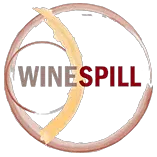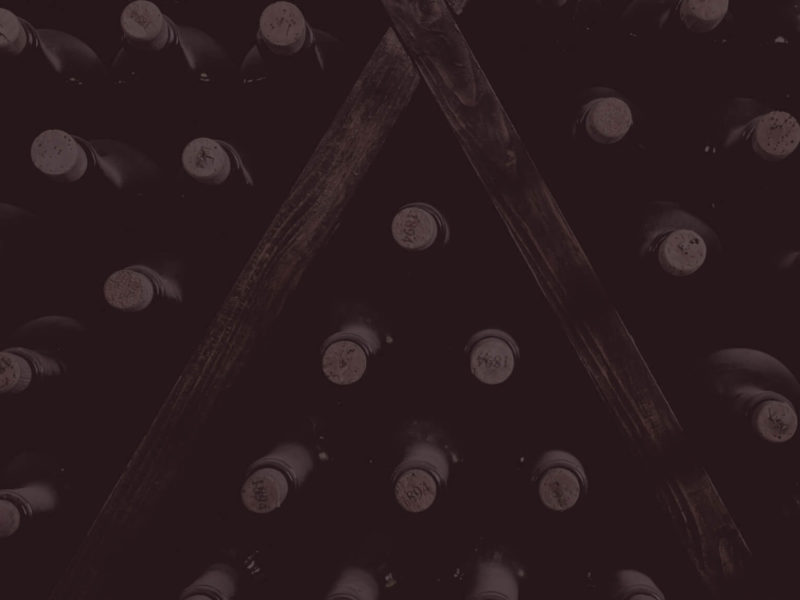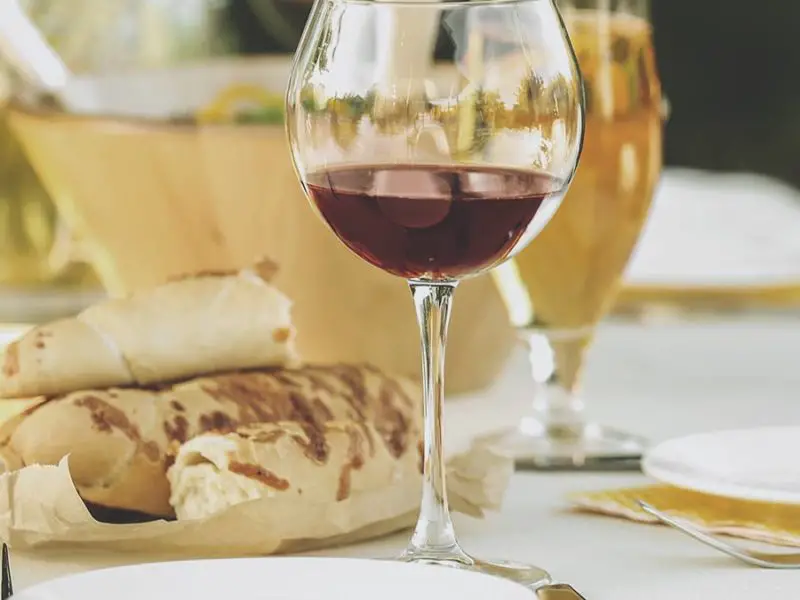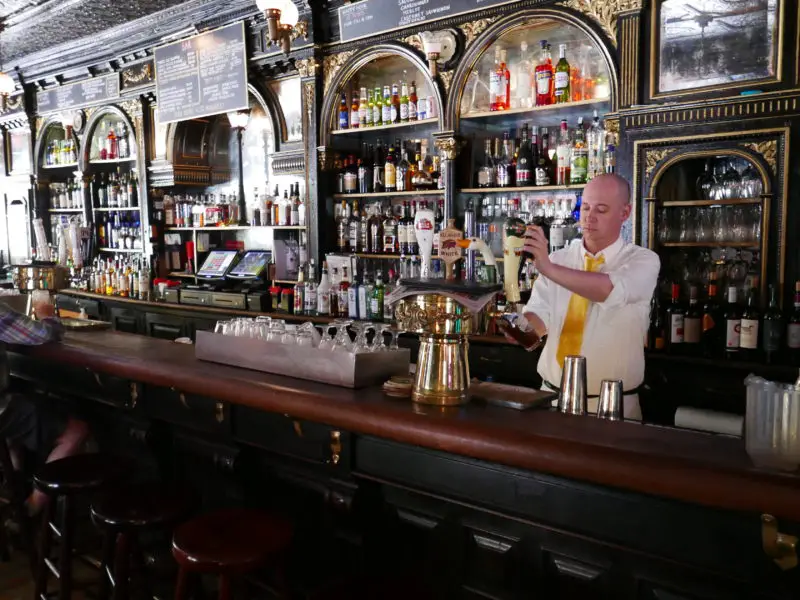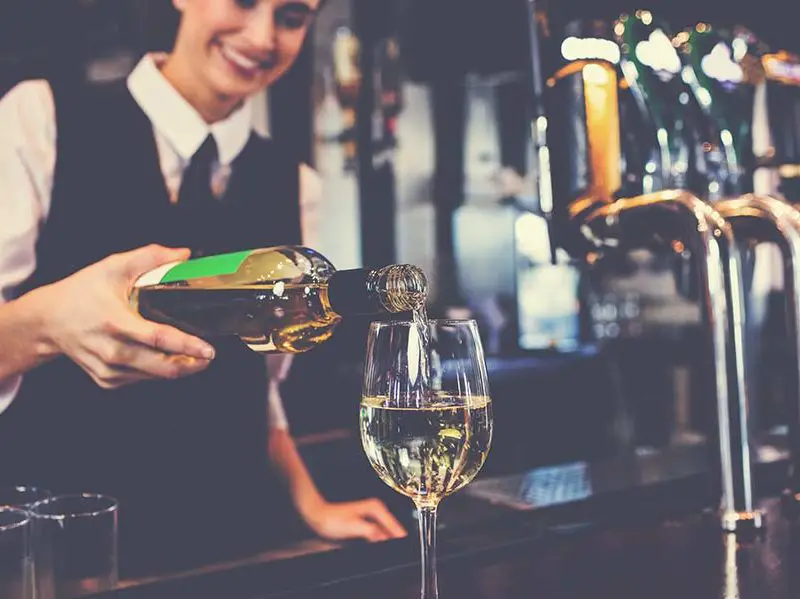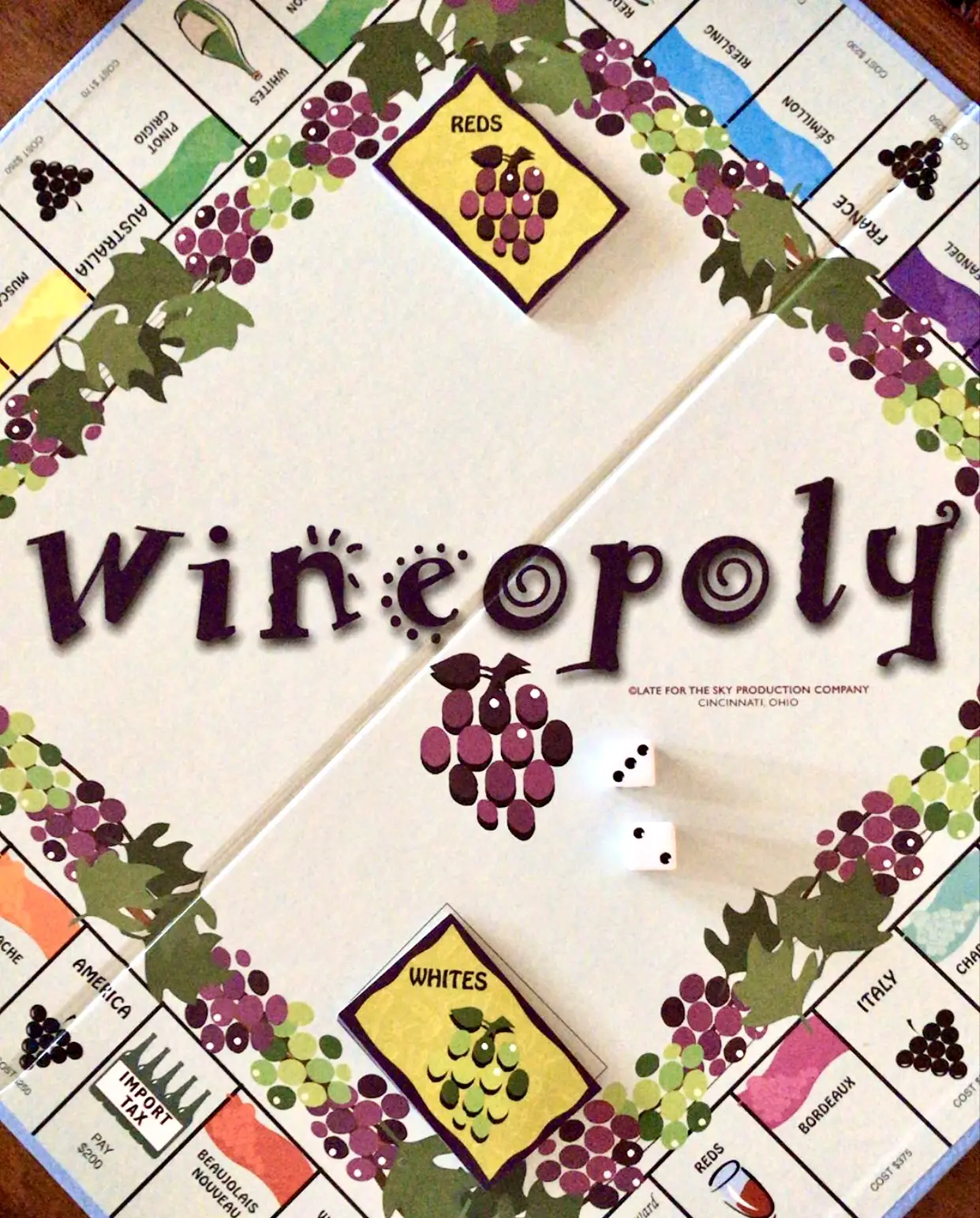
The business of wine ~ Play the game of Winopoly – My Winespill
If you have played the game of monopoly in your childhood then you will easily play the game of Winopoly.

Play the game of Winopoly
What a fun way to spend time with friends playing the game of Winopoly and learning about wine together. Not far off from how you remember playing the original game of Monopoly, but with a touch of savior faire. Learn how to taste and notice the difference between each wine type. It will make each drinking occasion unique and memorable.
The change in Winopoly that is immediately noticeable is the wine cellar, where players are sent to age. If you are sent to the wine cellar, you must go directly to the Wine Cellar and do not pass Cheers or collect $200. Your turn ends.
You will be able to commence play after you have rolled a double, or after 3 turns of not rolling a double, you must place a $100 bill in the center of the board and move ahead as usual on the next turn. The sad event happens when landing on the Wine Cellar space during regular play and you are “already aged”. While you are sentenced to age in the wine cellar all business continues as you buy or sell property, buy or sell grapes or decanters as well as collect rent.
Choose your token of play. There is a carafe, a chunk of cheese, a bunch of grapes, a chalice, a cork and a bottle of wine. Assign the banker, who is the keeper of money, deeds, bunches of grapes and decanters, until purchased. When you land on the “Red” or “White” spaces you must draw from a stack of cards and learn that you’re “starting a home wine cellar—lose one turn for construction” or that there’s “red wine on your little black dress—pay $50 for cleaning.”
The bunches of grapes are bought like houses and you can trade up to decanters as you would a hotel.
Starting in the center of the board each player rolls the dice and the player with the highest roll advances to “Cheers” counting this space as one and progresses the remainder of the roll and play passes to the left.
Each wine region contains a group of grapes of the same color from the low valued wines to the highest priced wine. As you land on the different grape varieties you can purchase the set and collect bunches of grapes that you can trade up for decanters. Add import taxes and serving faux pas, become the president of the wine club or be penalized for spilling wine on your cocktail dress until someone has bought up all the vineyards and the other players are broke.
Hours of fun, making deals and learning about wine. Don’t worry, there is no mention of the federal labeling standards, so no need to know if your wine is truly where the labels says it is from.
Sangria (San-GREE-uh) wine
The first, least respected group of wine, contains Sangria. A mixture of red wine, fruit juices, and sparkling water, garnished with a generous amount of thin-sliced citrus fruit. The ingredients consist of:
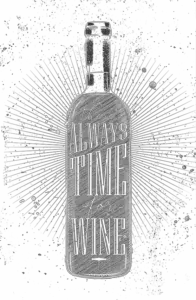
- 1 (750-ml) bottle red wine
- 1/2 cup brandy or cognac
- 1/4 cup orange liqueur (recommended: Cointreau)
- 2 tablespoons superfine sugar
- 1/2 cup orange juice
- 1/2 cup club soda
- 1 medium unpeeled orange, sliced
- 1 unpeeled lemon, sliced
There is also a version made with white wine that is called Sangria Blanco. This is bottom shelf wine you can find at a local HEB for close to $6 a bottle, a great summertime sipper.
Beaujolais Nouveau (Boe-zho-lay Noo-voe) wine
Beaujolais Nouveau is also part of this first group. The first wine of the new Beaujolais vintage is a light, fruity red wine from the region of the same name in Southern Burgundy, France. It is traditionally sold on the third Thursday of November and is best when consumed before the end of the year.
The Railroads – I was born in the USA
To play the game of Winopoly you will find many similarities to the original game. In place of the railroads, you will find four of the main country producers of wine: Australia, France, Italy, and America. In the first stretch, you will have the chance to purchase America. Based on annual production, the United States ranks as the 4th or 5th largest wine-producing country in the world. At least 90 percent of U.S. wine comes from California, which, if it were a nation, would rank 5th or 6th in terms of world production. Wines of all styles are being produced by approximately 1400 wineries scattered over at least 44 states. Over the past 35 years, innovation and technology have increased the quality of U.S. wine. During that time American wine consumption has also risen about 400 percent due to a consumer culture eager to learn and experiment with foreign and domestic wine. You can place Texas as an emerging wine region on the cusp of something great, as well as New York, Washington, Oregon, Virginia and, of course, California.
Grenache (gruh-NAHSH) wine
Moving along the board to the next group you are offered to purchase a Grenache. This red wine grape originated in Spain, where it is known as Garnacha. It is widely grown in hot, dry regions, most notably California’s central valley, southern France and Australia (might be good in Texas too). The wines produced from this grape are medium to full-bodied, sweet and fruity with mildly spicy flavors.
Sangiovese (sahn-joe-VAY-zeh) wine
An Italian grape, Sangiovese, is the main red wine in Italy’s Tuscany region. It is a primary component of the Chianti blend and its clones. It is used as a varietal in California where Cal-Ital wines are popular and produce a hearty dry red with the flavor of black cherries.
Tempranillo (temp-rah-NEE-yah) wine
The last grape in this group is the Tempranillo, which is the most pedigreed Spanish red wine grape making world-class wines in Rioja and Ribera del Duero. It is described as a dark lush fruit that produces deep-colored wines that age well; a full wine with strawberry, spice, and fresh tobacco components.
Gamay (ga-MAY) wine
Rounding the corner as an aged player we land on Gamay. This is a red wine grape of the Beaujolais region in Southern Burgundy, France. You can drink this wine right away, it is light, fresh, fruity with soft tannins and high acids, similar to a Pinot Noir. The coloring is purple and is distinguished by flavors of peaches, bananas, and berries.
Syrah (see-RAH) wine
Syrah is a high-quality red wine grape from the Rhône region in France. It is the principal grape in Hermitage and Côte-Rôtie and is blended in the multi-variety wines from Châteauneuf-du-Pape and Côtes-du-Rhône. It is a full-bodied, tannic, age-worthy wine that has a spicy blend of black pepper and raspberry aromas with dark fruit, smoke and tar flavors.
Muscat (MUHS-kat) wine
Muscat is an ancient grape grown in temperate climates around the world such as Spain, Italy, Australia, California, France, and Greece. Varieties of this grape differ in color from light green to almost black, yet it makes flowery, grape-flavored wines with a musky scent ranging from lighter whites to sweeter dark versions.
Australia Mate
The mid marker country you’ll pass or get the chance to purchase is Australia. Australia has been an emerging powerhouse in the wine world since the 1970s. Over the past 30 years, their modern arsenal of winemaking equipment and technology has enabled them to produce wine at reasonable prices. Today, they are being recognized worldwide for a variety of fine wines and all major styles. Then on to the last group of wine on this side of the board.
Pinot Grigio (Pee-noh GREE-joe) / Pinot Gris (PEE-NOH GREE) wine
Pinot Grigio is the Italian name and Pinot Gris is the French name of the same grape that produces white to slightly pink wines. The grape is commonly found in the Alsace region of France and Northeastern Italy. The styles range from the rich, fat, sweet, French version to the crisp, light, dry, Italian version.
Sauvignon Blanc (soh-VEE-nyawn BLAHNGK) wine
Sauvignon Blanc is a white grape native to the Loire and Bordeaux regions and widely cultivated in California, New Zealand, Italy, Australia, and South America. They have varied styles based on the region’s climate, canopy management, and casking. They are crisp wines that are inherently citrusy with a grassy herbaceous aroma and flavor.
Chablis (shah-BLEE) wine
Chablis, a fine white wine made from Chardonnay grapes and produced near the town of Chablis in France’s Burgundy region. Outside of France, it is used as a generic term for inexpensive “white wine” made of various grape varieties. In contrast to the sweeter generic Chablis, the French wines are dry, austere, and flinty.
Chateau Darling, I want Money
If you land on Chateau you win the kitty in the middle. To play the game of Winopoly all of the money required to be paid other than rent and purchase price of the property sits here.
Riesling (REEZ-ling) wine
On to the wines that are hard to say and even more difficult to spell. Riesling is a native of Germany. A white wine grape that produces some of the best wines in the world. Alsatian and Californian Rieslings are also noteworthy. It is vinified in a variety of styles from bone dry to very sweet. The better wines are usually slightly sweet with a hint of soft citrus, they have aromas of floral, fresh apples, and lightly spiced.
Gewürztraminer (geh-VEHRTZ-trah-mee-ner) wine
Gewürztraminer is a white wine grape most notably planted in France’s Alsace, Germany, Slovenia, Servia, Austria, Bulgaria, Croatia, Hungary, Greece, Luxembourg, the Czech Republic, Slovakia, Romania, North Macedonia, and Turkey. In the New World, the grape is grown in Northern Michigan, though it is perhaps most successful in New Zealand. It is also grown I n Mendoza, the most important wine region of Argentina and the far south of Chile. In the Middle East, the grape is grown in the Golan Heights. Highly aromatic wines with a mix of litchi fruit, roses, and pears as well as spices of cinnamon, cloves, and nutmeg. The wine is full-bodied and crisp, it varies in sweetness from off-dry to late-harvest sweet.
Sémillon (seh-mee-YOHN) wine
Sémillon is a white grape native to Bordeaux but also planted in North and South America, Africa, Australia, and Europe. By itself, the Sémillon grape produces neutral-flavored, mediocre wines. When blended with sauvignon blanc, it creates exceptional wines. Wines from Bordeaux often use it in the blend, especially the world-class sweet wines.
Viva La France
The mid marker country you’ll pass or get the chance to purchase is France. France is the standard for fine wine by which all other wine-producing countries are measured. It is the second-largest wine-producing nation in the world and its population consumes more wine per capita than any other country’s people. It has an ideal geography and climate for growing grapes and a rich history of winemaking. French wines are distinguished by the area in which they are produced and a system identifying quality that has yet to be duplicated anywhere else in the world. You must visit France to play the game of Winopoly, and continue on to the seasoned reds.
Zinfandel (ZIHN-fuhn-dell) wine
One of my favorite wines that I like to describe as distinctively spicy is Zinfandel. This red wine grape is considered America’s own and is California’s most extensively planted grape. It is vinified in many styles including the pink, fruity, White Zin, the light nouveau style, the robust hearty reds, and the late harvest Zinfandel. At its best, it makes a big, fruity, full-bodied red wine with a mixture of dark fruit flavors and scents with plenty of tannins and alcohol.
Merlot (mehr-LOH) wine
Next up is Merlot, this red wine grape from France has gained popularity as a varietal among Americans. Its smooth, mellow style makes it a good “entry” wine for new red wine drinkers. It is the main grape of Saint-Émilion, Pomerol, and a major part of the great Bordeaux blends. Merlot wines are soft, round, and fruity with low tannins and higher alcohol content.
Pinot Noir (PEE-noh NWAHR) wine
To Play the game of Winopoly, as in Monopoly, the next street contains the wine which is my favorite middle age wine to drink, Pinot Noir. Perhaps because the Pinot Noir grape itself ranks with some of the oldest grapes in the world that give it the well polished flavor. Burgundy, France is the home of this world-class red grape that has proven difficult to grow and vinify well elsewhere. In its youth, the wine is fruity with cherry, plum, raspberry and strawberry flavors. As it matures it takes on more complex, earthy qualities, but young or old, always possesses a smooth texture and velvety finish. Pinot Noir has a natural ability to be lighter than other red wines and have low tannin. Pinot Gris/Grigio and Pinot Blanc are simply color mutations of the Pinot Noir grape. Each grape DNA was analyzed only to find out they are identical. So, if you like Pinot Noir, start drinking all the Pinots!
Cabernet Sauvignon (ka-behr-NAY soh-veen-YOHN) wine
Cabernet Sauvignon is one of the world’s most successful and popular red wine grapes and the primary grape of the top vineyards in Bordeaux. It is also the varietal responsible for the superb red wines of California’s Napa Valley. Being high in acid and tannins, it blends well, imparting its structure and longevity, while rounding out its mighty characteristics. It possesses flavors and aromas of black currant, cherry, raspberry, cedar, and tobacco which tend to pair well with a nice steak dinner.
Burgundy (BER-gun-dee) wine
If you’ve never tasted a Burgundy, you have probably heard of Burgundy. It is one of the world’s most famous wine regions, located southeast of Paris, France. It is broken down into five basic regions with considerable variation from region to region. The major focus within Burgundy is on three grape varieties; Pinot Noir (Red Burgundy), Gamey, and Chardonnay (White Burgundy). Outside of France, Burgundy is a generic term referring to inexpensive red wine.
Chardonnay (shar-doh-NAY) wine
One of my favorite not too sweet wines is a world popular, Chardonnay. It is a high quality, versatile (used Champagne), white wine grape whose reputation was established in France’s Burgundy region. The grape is easy to grow as evidenced by extensive planting and excellent wine production in California, Australia, Italy, New Zealand, Spain, and South Africa. It has flavors and aromas of butter, apple, vanilla, oak, and pineapple.
Italy, La famiglia è la patria del cuore
The mid marker on the last stretch of the game is my favorite country to visit, Italy. Italy produces more wine and wine varieties than any other country in the world. They are also the world’s top wine consumers by volume (France is tops per capita but Italy has a larger population). For the past 3500 years, Italy has been making a variety of wines in a variety of ways. Their basic wine laws, instituted in 1963, were devised to regulate the many varieties, their quality, yields, and restrictions. These measures ensure that the quantity of wine produced does not overshadow the fact that Italian vino ranks among the world’s best.
Bordeaux (bohr-DOH) wine
Closing in on Cheers are the most expensive and best quality wines. Bordeaux is the world-famous wine region located in the southwestern portion of France. It is considered by many to be the world’s greatest wine-producing region based on the quantity (500 to 750 million bottles annually) and the high quality of its wines. The region has gained the most notoriety for its red wines, accounting for over 75 percent of all production. Nonetheless, the region’s dry, white wines from Graves and sweet white wines from Sauternes are highly acclaimed.
Champagne (sham-PAIN) wine
Finally, to play the game of Winopoly, you strive to land on to the celebratory wine, Champagne, the most coveted space to own. Sparkling wines are produced throughout the world, but true Champagne comes only from France’s northernmost grape growing area, the Champagne region. The cooler climates in the region 90 miles northeast of Paris don’t allow the main grape varieties (Chardonnay, Pinot Meunier, and Pinot Noir) to fully ripen. The results are higher acids and less developed flavors which happens to be the perfect formula for world-class Champagne.
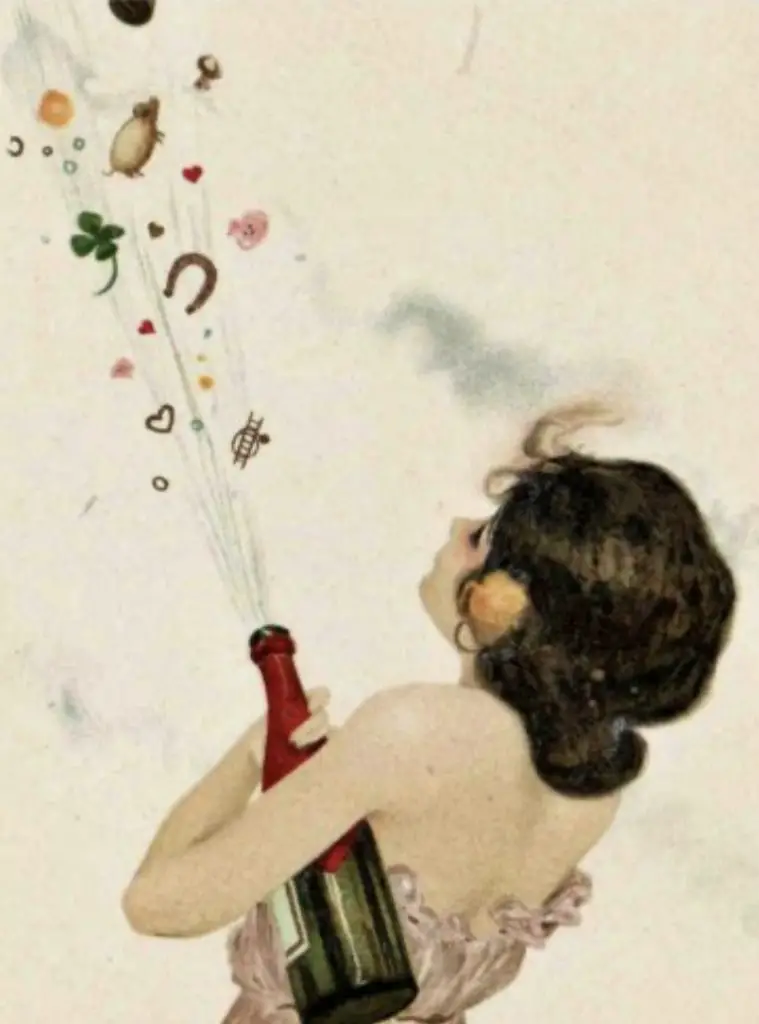
Play the game of Winopoly
The Romans were the first to plant vineyards in this area of north-east France, later, churches owned vineyards and monks produced wine for use in the sacrament of Eucharist.
Contrary to legend and popular belief, Dom Pérignon did not invent sparkling wine, though he did make important contributions to the production and quality of both still and sparkling Champagne wines.
The oldest recorded sparkling wine is Blanquette de Limoux, which was invented by Benedictine monks in the Abbey of Saint-Hilaire, near Carcassonne in 1531.
The Devils Wine
In France the first sparkling Champagne was created accidentally; the pressure in the bottle led it to be called “the devil’s wine” (le vin du diable), as bottles exploded or corks popped.
Even when it was deliberately produced as a sparkling wine, champagne was for a very long time made by the méthode rurale, where the wine was bottled before the initial fermentation had finished. In 2007, champagne sales hit a record of 338.7 million bottles.
In the 19th century, champagne was noticeably sweeter than the champagne of today. The trend towards drier Champagne began when Perrier-Jouët decided not to sweeten his 1846 vintage before exporting it to London.
If you were able to play the game of Winopoly and finish, the winner at the end of the game, who is the richest player, can toast to his opponents and open a bottle of bubbly. If you want to buy it now, here is a direct link to Amazon:
Wine Gifts 
Wine-Opoly Monopoly Board Game for $19.15
[eltdf_button type=”outline” size=”medium” text=”Wine-opoly — Amazon” icon_pack=”” font_weight=”400″ link=”https://amzn.to/35V1P9x” color=”#9d967c” border_color=”#9d967c”]
Wine Origin
One of the complexities underlying the world of wine is that the product has almost always place-specific origins. Its management is therefore not only the management of a single enterprise, but also the collective management of a region.
Managers within the wine industry must consider how to make their business more effective, and also engage with others around them to promote their area as well.
Additionally, because a diverse selection of wine is offered, a great deal of the distribution is specialized. Despite the recent growth in sales in supermarkets in many countries, specialist stores, on-premise sales, sommeliers and wine critics are all still an essential part of the industry. The result of these two factors is that it is hard to talk of a single type of “wine business”. Wineries and vineyards present themselves as an adventure into the life of viticulture. Visit a vineyard!
